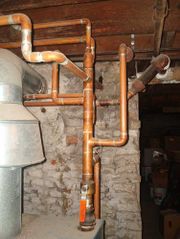Water Worlds
Water is the major natural reservoir for
Legionella pneumophila
although they can survive in other environments such soil as well. The
bacteria are found in many different natural
 and artificial aquatic environments with ranges of various environmental conditions. They
occupy natural environments such as ponds, slow-flowing creeks,
and artificial aquatic environments with ranges of various environmental conditions. They
occupy natural environments such as ponds, slow-flowing creeks, devices, spa tools, hot tubs, drinking water supplies,
showerheads, and others. The source of
Legionella pneumophila in the
case of the investigation of the Legionnaires’ Disease outbreak turned
out to be the actual
 water in the hotel.
(See
Bicentennial Bacteria
for more information!)
water in the hotel.
(See
Bicentennial Bacteria
for more information!)
Their affinity for hot-water tanks or thermally
polluted rivers shows just how important water temperature is in regards
to the colonization of this particular species.
Legionella pneumophila
has demonstrated that it can withstand temperatures of 50°
C (122°F
) for several hours.
However, it doesn’t multiply below 20°
C (68°F),
but remains dormant. (Therefore, in an
 effort to prevent Legionella
infections, it is recommended that cold water ideally be stored below 20°
C (68°F).
effort to prevent Legionella
infections, it is recommended that cold water ideally be stored below 20°
C (68°F).
Biofilms, which are mixtures of bacteria, protozoa
and other microorganisms present in water that adhere to an object
submerged in water, may serve as a natural habitat and reservoir for
Legionella pneumophila in
many artificial water environments.
serve as a natural habitat and reservoir for
Legionella pneumophila in
many artificial water environments.
Legionella
Pneumophila
is an inhabitant all over the globe.
However, the ecological niches that support this organism, such
as complex water systems, aren’t as common in developing countries.
This results in a lower frequency of
Legionella pneumophila
infections in these nations.
But it is believed that the difference in the rates of infection
is probably more strongly linked to the
over the globe.
However, the ecological niches that support this organism, such
as complex water systems, aren’t as common in developing countries.
This results in a lower frequency of
Legionella pneumophila
infections in these nations.
But it is believed that the difference in the rates of infection
is probably more strongly linked to the variances in definitions and data
presentation as well as a deficiency in diagnosis methods and
surveillance systems.
variances in definitions and data
presentation as well as a deficiency in diagnosis methods and
surveillance systems.
